ISSN 2348-1196 (print)
International Journal of Computer Science and Information Technology Research ISSN 2348-120X (online) Vol. 8, Issue 3, pp: (147-160), Month: July - September 2020, Available at: www.researchpublish.com

ISSN 2348-1196 (print)
International Journal of Computer Science and Information Technology Research ISSN 2348-120X (online) Vol. 8, Issue 3, pp: (147-160), Month: July - September 2020, Available at: www.researchpublish.com
Abstract: Some students suffer from learning the Arabic language and the lack of online platforms that may help them in meeting what they want to learn as well as teachers who do not have work opportunities and have experience in teaching, as well as some schools that spend a lot of money to teach their students. In addition, this paper is a solution for those people who want to learn but they cannot pay for their tuition fees so the system will also build a donation center for B40 people, where donors will be able to directly donate for the B40 people. This paper which is to propose an online platform to expose Arabic learners to a web application System that aims to help them to overcome linguistic obstacles, have a good chance to practice with native teachers, as well as reach the main source of the language. The design and system thinking approach [2][7] has been adapted in this paper to address the Arabic language proficiency of students, business people & tourists of Malaysians & possibly other ASEAN countries through understanding their needs, and then followed by building conceptual business models using modelling tools, i.e. Business model canvas (BMC) [8] and Value proposition design canvas (VPC)[9]. This paper offers validated conceptual Malaysian University-of-the –Future (UotF) business models with focus on community engagement programmes. The value proposition of the conceptual business model is to enhance the Arabic language proficiency of students and B40 students; and business people and tourists of Malaysians/ASEAN countries through Arabic Arab4U Digital Education Programme and Platform.
Keywords: C2C, Digital Education Platform, Arabic education, UotF, Business Model, BMC, VPC.
In the 21st century, learning new languages seems to be somehow a necessity of life. Learning the languages can enhance the opportunities in many aspects of life such as education [include doing further Islamic studies in Arab countries e.g. Egypt, Jordan & Morocco by international students, business, and religion. To illustrate, in the business field, gaining different languages can assist the businessmen and women to have more powerful chances to invest in other parts of the world. Four out of five new jobs are being created in the United State as a result of foreign trade.[3] In other words, the language considered to be a source of the belief such as Islam. In fact, Islam is based on two major sources, the Quran, and Sunnah; However, both are formulated in Arabic. Consequently, Muslims who represent 23% of global population with a number of 1.6 billion (Pew Research Center, 2012), are required to learn Arabic to be able to understand the teaching of Islam as well as to Islamic practice such as, prayers, supplication, and recitation. Most importantly, in some languages, beliefs are placed on the top of certain languages. In other words, the language considered to be a source of the belief such as Islam. In fact, Islam is based on two major sources, the Quran, and Sunnah; both are originated in Arabic.[4] Basma Ahmad Sedki Dajani, Salwa Mubaideen, Fatima Mohammad Amin Omari (2013) stated: “The process of teaching Arabic for speakers of other languages can be effective through some overlapping factors; teachers’
ISSN 2348-1196 (print)
International Journal of Computer Science and Information Technology Research ISSN 2348-120X (online) Vol. 8, Issue 3, pp: (147-160), Month: July - September 2020, Available at: www.researchpublish.com
characteristics, learners’ characteristics, program, programs’ ability to meet the learners’ needs and the audio-visual aids. These factors should integrate and work harmoniously in order to give the desired results. This study aims to help teachers to improve the program, teaching skills and students’ language acquisition. It is also useful in giving the teachers an understanding of the current overall situation of the program.”.[15]
Muslims who represent 23% of global population with a number of 1.6 billion (Pew Research Center, 2012),[4] are required to learn Arabic to be able to understand the teaching of Islam as well as to Islamic practice such as, prayers, supplication, and recitation. Due to the fact that Arabic language is considered one of the most spoken languages around the world as Pew (2012) mentioned that the language of the Quran (Arabic language) is being used by over 1.6 billion Muslims. Some digital platforms were developed to respond to that demand. Yet those systems do not seem to be qualified in all aspects including functionalities, user-friendly design, and system dedication. Most studies on the factors contributing to the problem of Arabic speaking skill share similar findings. Some of these are: a) lack of practice, b) poor vocabulary, c) poor learning environment, d) low self-confidence, e) lack of partners to communicate, f) poor command of Arabic grammar, and g) shyness and feeling intimidated (Nafi, 1995; Tarmizi, 1997; Ismail, 1999; Hasanah, 2001; Anida, 2003; Amilrudin, 2003; Khalid 2004; Mohd. Zaidi, 2005; Zawawi et al., 2005, and Siti Ikbal, 2006). In addition, some students face difficulties in paying the tuition fees so this project will give them scholarships so they cannot make their future. There are several benefits of online platforms especially during these difficult days due to COVID-19. To illustrate, Wiley (2020) stated about the benefits about the online education:
Six specific instructional strategies are presented to summarize current online teaching experiences for university instructors who might conduct online education in similar circumstances. The study concludes with five high-impact principles for online education: (a) high relevance between online instructional design and student learning, (b) effective delivery on online instructional information, (c) adequate support provided by faculty and teaching assistants to students; (d) high-quality participation to improve the breadth and depth of student's learning, and (e) contingency plan to deal with unexpected incidents of online education platforms.[1]
Hence, there is an urgent need to create a digital Arabic learning platform with efficient content in order to educate people and confront the problems they face.
The primary objective of this study is to develop a solution using the conceptual design approach through a validated business model that enlarge the number of Arabic learning in Malaysia. In addition, by offering online study so it reaches many people and build a conceptual UotF biz model, that will enhance the soft skills of an individual as well as it will help the youth with hard skills to survive in the real world. Furthermore, providing affordable learning Arabic service, giving affordable prices and offer opportunities for jobs, these solutions will reduce the poverty rate and enhance wellbeing by increasing the knowledge and skills of the youth in the poor community. Also ensure that all students have quality and balanced education. This paper offers validated conceptual Malaysian University-of-the-Future (UotF) business models with focus on community engagement programmes. The value proposition of the conceptual business model is to enhance the Arabic language proficiency of students and B40 students, business people & tourists of Malaysians/ ASEAN countries before going to the MENA countries through Arabic Arab4U Digital Education Programmes & Platform.
This paper adopted the design and system thinking approach [7] to develop a conceptual business model of a Malaysianbased UotF[10] – focusing on implementing relevant community engagement programmes and activities. The value proposition of the conceptual business model [9] is to address the Arabic language proficiency of students, business people & tourists of Malaysians & other ASEAN countries through Arab4U Digital Education Programme & Platform. The conceptual business model is developed through understanding the needs of students, business people & tourists by using business modeling tools i.e. Business Model Canvas [8] (BMC) and Value Proposition Design Canvas [7] (VPC). The approach involves carrying out a literature review to identify key challenges and issues of various customer segments (CS, formulating and devising an initial conceptual business model – in the form of BMC and VPC, and a value proposition to enhance the students, business people & tourists‟ Arabic proficiency. The initial BMC is validated by interviewing some lecturers from the IT department, And the initial VPC is validated by interviewing various customer segments (CS) (students, business people) within the international Islamic university of Malaysia (IIUM)
ISSN 2348-1196 (print)
International Journal of Computer Science and Information Technology Research ISSN 2348-120X (online) Vol. 8, Issue 3, pp: (147-160), Month: July - September 2020, Available at: www.researchpublish.com
A. IR4.0 in Arabic Education and E-learning platform:

Literature review helps researchers to have a comprehensive overview of the problem that existing systems are attempting to overcome. In addition, the literature review lists out all the existing systems in the market and contrast between them in terms of the features they have provided and the good sides they have probably missed. The mature online teaching platform is equipped with a perfect learning management, resources sharing, effects analysis and other tools as well as it has achieved satisfied teaching effects after some trials on the cooperation and exchanges among people (Han,2014). In other words, this review highlights the advantages and disadvantages of existing products, and thus help the developers to build on the top of the advantages and eliminate the disadvantages. The E-Learning platform has gained a competitive edge over the prevailing traditional methodology [12][3]. As Noorul Hassan Naveed Quadri, Abdul Hafeez Muhammed, Sumaya Sanober, Mohamed Rafik N. Qureshi, Asadullah Shah (2017) stated about E-Learning teaching-learning methodology that: “It provides more flexibility and allows freedom from time, place, physical presence, hectic, and stressful teaching-learning etc., thus plays a vital role in the education system”. From that point, Arabic education can exploit advanced technology by creating a massive number of Arabic learning platforms. For example, in Malaysia, a large number of students are learning Arabic language so that e-learning may help them to achieve their goals. By providing online distance learning (ODL), learning management system (LMS), and others , E-learning provides opportunities to higher educational institutions in Malaysia to grow rapidly.Yet, little research on how university students adopt and use e-Learning have been conducted, especially in Arabic language programs (Mohammad Taufiq Abdul Ghani,Wan ab aziz wan daud 2017). And from a set of questionnaire Mohammad Taufiq Abdul Ghani,Wan ab aziz wan daud 2017 of 100 diploma in Islamic Studies students of Sultan Azlan Shah University (USAS), Kuala Kangsar, Perak they found that positive result responses in adopting e-learning as an effective medium towards language learning due to its advantages and benefits them in learning process.
As far as this project is concerned, there are few websites that have been developed, which share the same features of the proposed system. All of them are available on the Internet. By conducting this system review, the researcher manages to obtain a good base to start.
Khairun Nisaa Mohd, Airil Haimi Mohd Adnan, Ahmad Ariffuddin Yusof,Muhamad Khairul Ahmad & Muhammad Anwar Mohd Kamal (2019) has made an online survey and based on the data collected, 136 participants they found the following statistics [14]:

ISSN 2348-1196 (print)
International Journal of Computer Science and Information Technology Research ISSN 2348-120X (online) Vol. 8, Issue 3, pp: (147-160), Month: July - September 2020, Available at: www.researchpublish.com
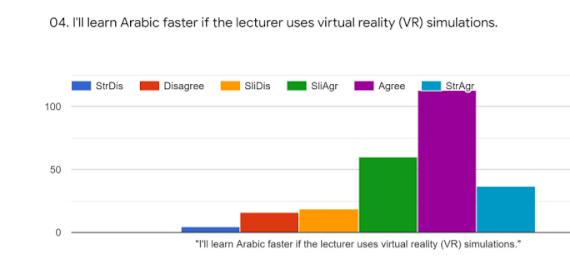

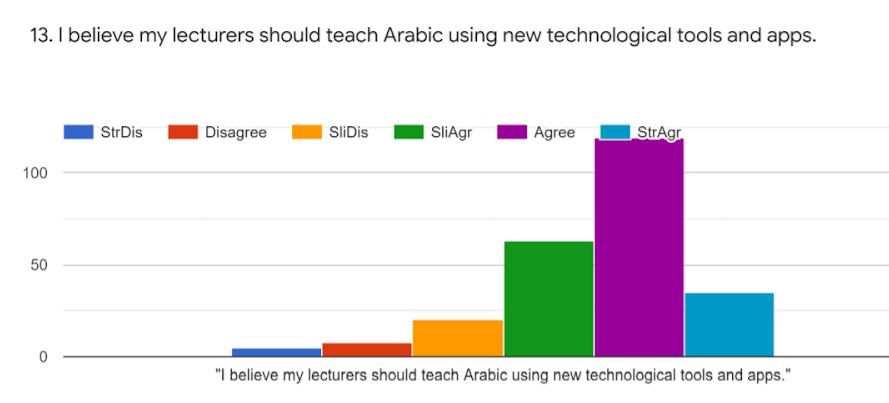

ISSN 2348-1196 (print)
International Journal of Computer Science and Information Technology Research ISSN 2348-120X (online) Vol. 8, Issue 3, pp: (147-160), Month: July - September 2020, Available at: www.researchpublish.com
The researchers have reviewed 3 different platforms which provide the same or similar service. The platforms are already running in the market therefore it gives the researchers a good perception of how the system should work based on the reviews of users of each system. In this section, the 3 systems will be reviewed extensively to identify the pros and cons which can inspire the developer of Arabic Learning Platform to provide a solid and user-friendly system. Among those existing products in the cyber that aimed to serve the same purpose of teaching and learning Arabic languages, here are 3 examples: Cambly ™, Preply ™, and Madinah Arabic ™.
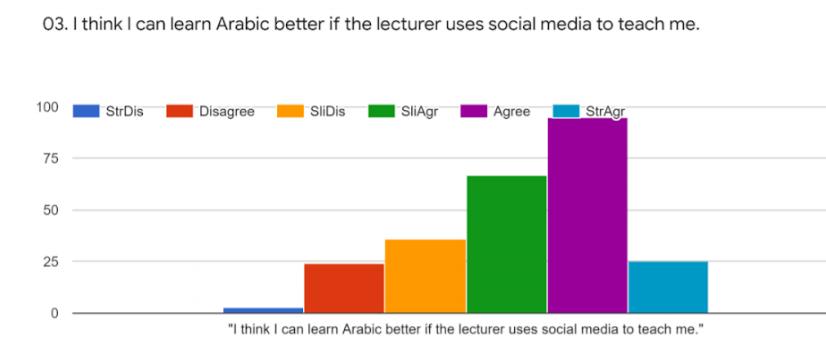
1) Cambly URL: https://www.cambly.com
Screenshot of the Home page of Cambly website.
Cambly system is meant to help English students as well as tutors to communicate effectively together. The system is providing a chance of non-native English speakers to have a chance to interact with native English people through a collaborative call video. On the other side of the system, people who feel they are qualified to be a tutor can register in the system to be viewed at the list of tutors. Furthermore, the system is equipped with great features to ease the process of students and tutor‟s communication with each other. A student can view tutors based upon their preferences of lesson type, lessons level, tutors‟ accent, tutors‟ availability.
On the other side of the system, Cambly is providing English materials which assist the students to have the chance to practice English with themselves.
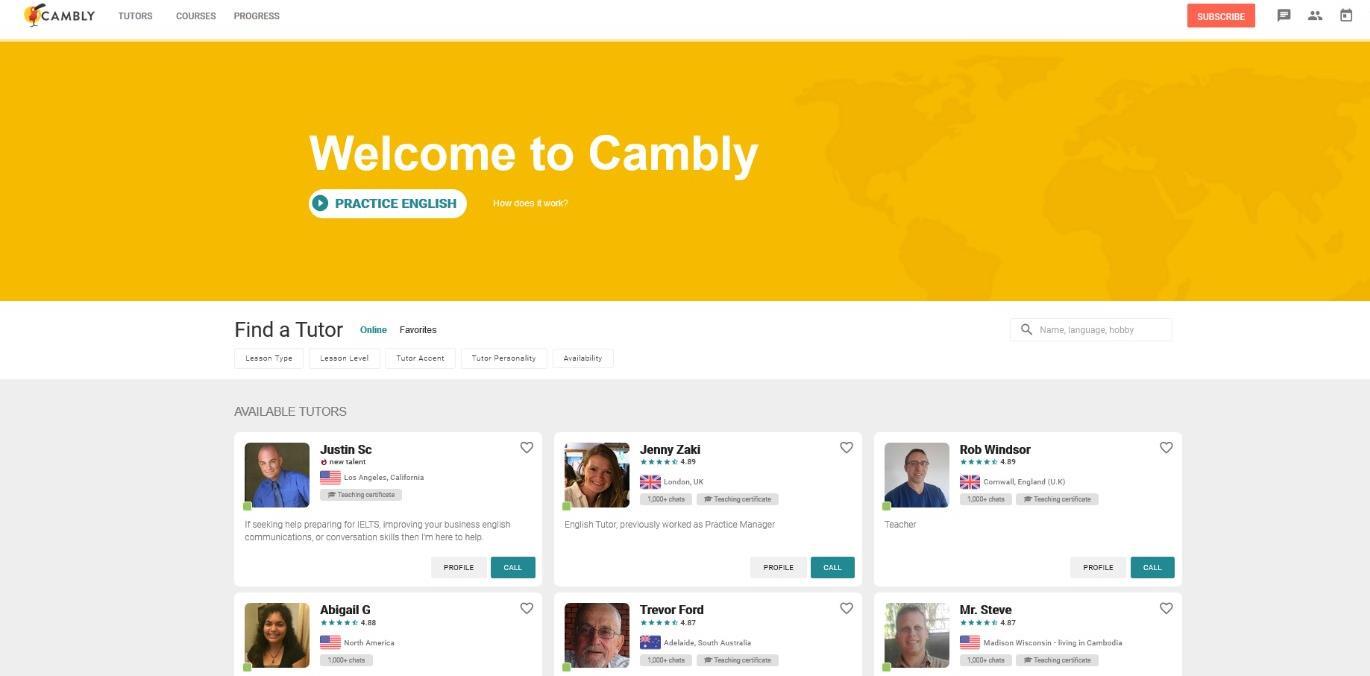
ISSN 2348-1196 (print)
International Journal of Computer Science and Information Technology Research ISSN 2348-120X (online) Vol. 8, Issue 3, pp: (147-160), Month: July - September 2020, Available at: www.researchpublish.com
Big influence in the market.
Reasonable cost.
Focus on English
Varity of courses
Good Marketing strategy.
High demand in the market.
Good reputation.
Mobile App.
b) Preply
URL: https://preply.com
Good reputation.

Tutor wages.
Technical issues.
Powerful competitors.
Screenshot of the Home page of Preply website.
Preply is a comprehensive system that focuses generally on the tuition service rather than on a particular subject. The system is providing a tuition service for approximately 80 different subjects, for languages service they offer tuition for English, French, Arabic and so on. In addition, the system offers other subjects such as programming languages, Mathematics, Physics, Arts, Music. For tutors and students to communicate before starting off the course Preply has provided messaging feature and trail lesson options. Eventually, after the students and tutors have communicated successfully, Preply supply a storing feature in which students can refer to later.
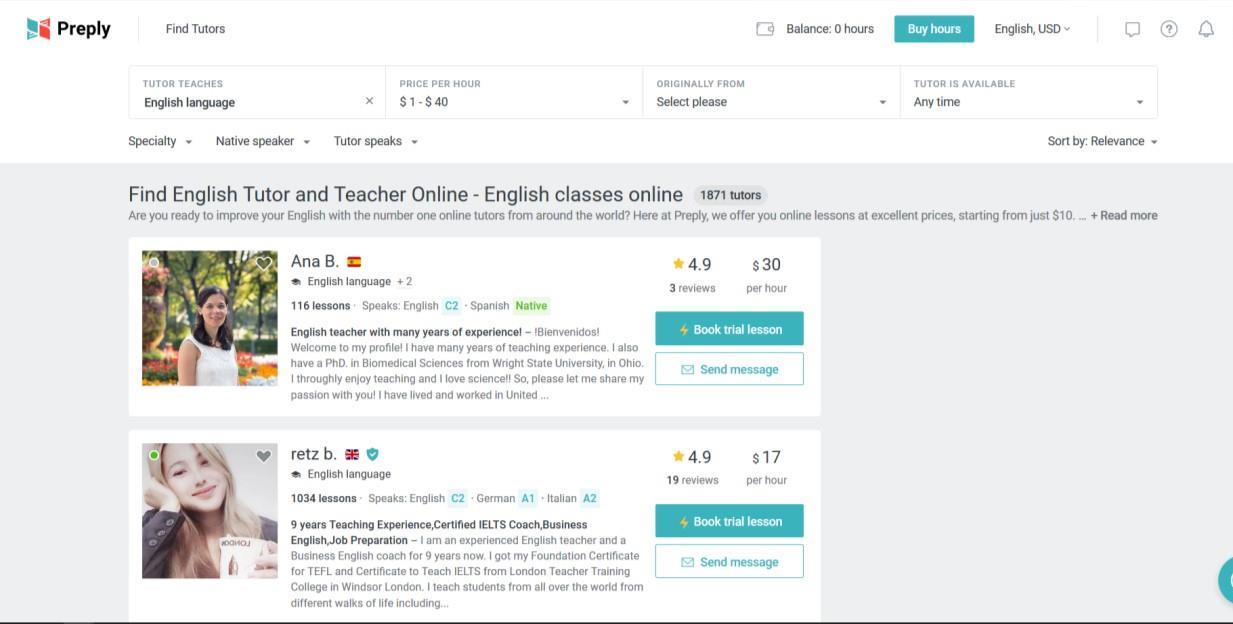
International level.
Verification system for tutor.
Tutor wages.
Opportunity
High demand in the market.
Different type of students.
Compatible with any Device
Threads
High cost
Complex.
Not dedicated for one subject.
Technical issues
Powerful competitors.
ISSN 2348-1196 (print)
International Journal of Computer Science and Information Technology Research ISSN 2348-120X (online) Vol. 8, Issue 3, pp: (147-160), Month: July - September 2020, Available at: www.researchpublish.com
URL: https://www.madinaharabic.com/
Screenshot of the Home page of Madinah Arabic website.
What is Madinah Arabic?
Madinah Arabic is designed mainly to serve the Arabic language. The website comprises sets of views, each view provides different functionalities and features. Arabic tuition is one of the views which aims to link Arabic learners with Arabic native tutors. A student can provide some preferable details such as time available, then the system will assign a tutor for the student. Madinah Arabic website additionally supplies the learners of Arabic with materials to practice what they have learned from their tutors.

Native speakers.
Various Arabic subjects (Grammar, Business…).
Opportunity Threads
High demand.
Lack of similar systems.
Poor UI/UX.
No digital marketing.
Poor design
Unverified tutors.
Absence of Validation system of tutor and student communication.
Arabic learning system will open opportunities for native and fluent speakers to get a job for teaching Arabic through our platforms. In other hand it will motivate student by letting them teach as well if they reach certain level as well as it will increase the economic by making news opportunities for students and teachers in addition it will increase the economic by making news opportunities for students and teachers.
We will conduct some interviews to identify the requirements of the students and teachers so we can meet their needs. Then we develop an online survey to get statistics and numbers about the project and opinions from the audience for Arab4U.
We develop initial business models to start up a new business, and we use it as strategic management and lean startup template for developing new business models. It describes a product's value proposition, infrastructure, customers, and finances. By leveraging the nine 9 blocks of Business Model Canvas (BMC) framework, Value Proposition, Customer Segment, Customer Relationship, Channel, Key Activities, Key Resources, Key Partners, Course Structure and Revenue.
ISSN 2348-1196 (print)
International Journal of Computer Science and Information Technology Research ISSN 2348-120X (online) Vol. 8, Issue 3, pp: (147-160), Month: July - September 2020, Available at: www.researchpublish.com
A. Students: Poor students (B40 students): For this type of students we are going to offer them opportunities to learn on our platform for free until they can be qualified in order to be teachers to work in our organization. Normal students (M40 students): for this type of students, they might get discounts in their courses so they can be satisfied in their study. Rich students (T20 students): they are going to pay the full fees.
Paid teachers: those who are going to teach in our platform but they are going to pay for the subscription in our system.
Volunteer teachers: those who have the ability to teach for free.
C. Service Provider: After the students can be qualified to teach in a professional, here is the destination for them to get opportunities for jobs in our system so they can benefit and we can benefit as well to enlarge the number of teachers and to make the scope of our system bigger and bigger.
D. Governments and organizations: We are going to help them in how to save their time and money by delivering to their students a good content.
E. Donors: we will also build a donation center for B40 people, where donors will be able to directly donate for the B40 students
The Value proposition canvas is used to understand the customer pains, gains and shows the expected services that the customer needs from the business.
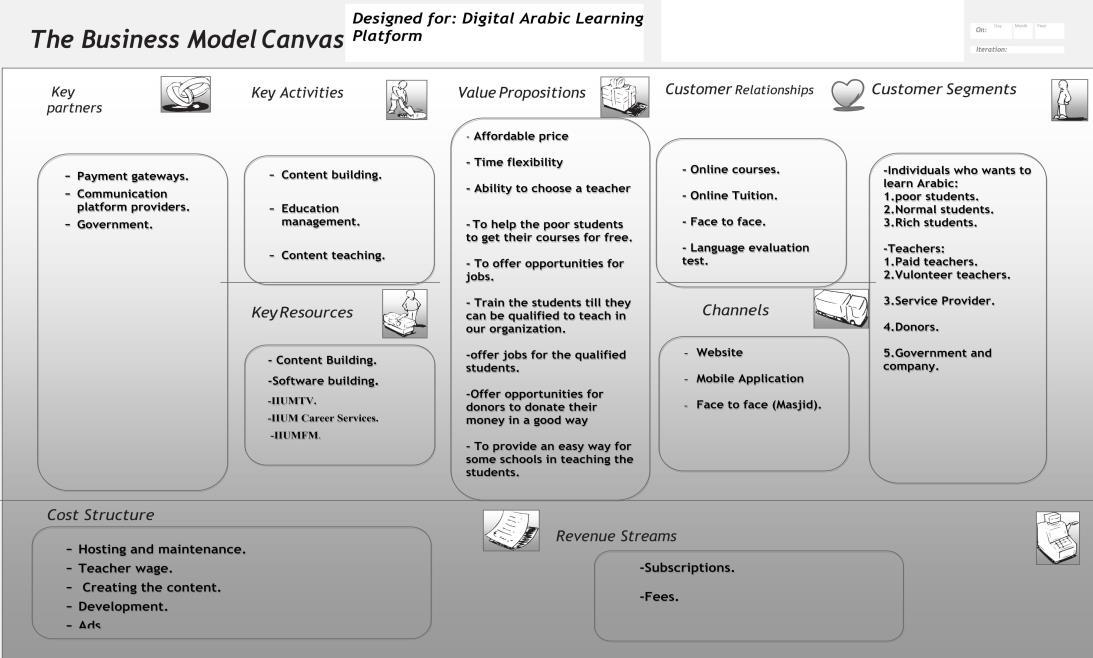
Poor learners. (B40 students)
-Learn Arabic and get qualified for teaching.
-Lack of understand Arabic.
-They cannot pay their fees.
-They cannot find a native Arabic teacher.
-free courses. -Qualification in teaching.
-opportunities for jobs.
- Open online. Professional tutors.
– Flexibility in time of learn.
- No need to pay for the fees of the courses.
- Job opportunities. Professional qualified teachers.
ISSN 2348-1196 (print)
International Journal of Computer Science and Information Technology Research ISSN 2348-120X (online) Vol. 8, Issue 3, pp: (147-160), Month: July - September 2020, Available at: www.researchpublish.com
Normal students. (M40 students)
Rich students. (T20 students)
-Learn Arabic and get qualified for teaching.
-Lack of understand Arabic -They can get a very cheap price. -They cannot find a native Arabic teacher.
-cheap courses. -Qualification in teaching. -opportunities for jobs.
- Open online courses. Professional tutors.
-Learn Arabic and get qualified for teaching.
-Lack of understand Arabic -They can get a very suitable price.
-They cannot find a native Arabic teacher.
-cheap courses. -Qualification in teaching. -opportunities for jobs.
- Open online courses. Professional tutors.
– Flexibility in time of learn.
- A very cheap price to pay for the fees of the courses.
- Job opportunities. Professional qualified teachers.
Flexibility in time of learn. - A very suitable price to pay for the fees of the courses.
- Job opportunities. Professional qualified teachers.
Paid teachers. - Increase Employability/ Self-employed.
Volunteer teachers. - Sharing knowledge & increase opportunities for jobs.
- lack of getting job opportunities. - Increase employability for people. - Promotion of organization.
-unable to get the chance to volunteer.
Donors. - donate their money in a good. -unable to donate -software problems
The government and the company.
Teach their students by professional students with a cheap price.
Face difficulties in how to save their time and cost to deliver to their students a good content of learning.
- Personal experience. -Increase employability for people.
Increase employability for people. -Helping people to get knowledge.
-Save money. -Quality of contents.
Reduce unemployment. Quality digital platform. -Quality content.
Reduce unemployment. Quality digital platform. -Quality content.
Reduce unemployment. -Helping a large number of people by support them to be qualified.
- Open online. Professional tutors.
- Creating Job opportunities.
-Helping the poor students to get free courses.
-Helping the poor students to get free courses.
Flexibility in time of learn.
- A very suitable price to pay for the fees of the courses.
-Job opportunities. Professional qualified teachers.
This is validated by interviewing some students as well as teachers so the total number of students were 62.5 % of 32 responses and the rest of responses were teachers within IIUM. In addition, we have conducted an online survey from students within IIUM to validate and refine our business plan. Here, we have visually interpreted the online survey (conducted through Google form). And after we ask for personal information, we focus on these following questions for our validation.
Do you face difficulties in learning Arabic language?
Would you like to contribute as? 1. Students 2. teachers
In your opinion, what is the purpose of learning Arabic?
If you want to learn Arabic language, why do you need to learn it?
Are you familiar with online learning platforms for Arabic?
If yes, what are key features or functions that you like?
ISSN 2348-1196 (print)
International Journal of Computer Science and Information Technology Research ISSN 2348-120X (online) Vol. 8, Issue 3, pp: (147-160), Month: July - September 2020, Available at: www.researchpublish.com
We have conducted a survey targeting students at IIUM, the survey was in the form of Electronic Google form, the respondents of the survey reached 23. Based on the survey by (Amer, 2020, Google Form: System for learning and Teaching Arabic Survey), 62.5% of Arabic learners have difficulties in learning Arabic language. Furthermore, those who chose „No‟, 34.4 they have no difficulties in Arabic language. For those who have difficulties, some of their difficulties are (there's a lot of rules and concept to be remembered, hard to read and spell, hard to keep up with the lecturer accent, Difficulty in finding environment to practice, Identifying the letters and also pronouncing the words and other difficulties). In addition, the main purpose of learning Arabic is for learn and understand the Quranic verses.
The total number of students were 62.5 % of 32 responses and the rest of responses were teachers within IIUM
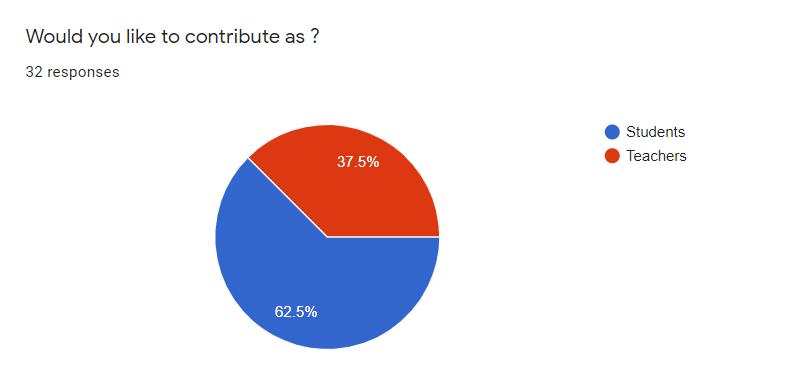
71.9% of learners want to learn Arabic to understand the Islamic better. (Amer, 2020, Google Form: System for learning and Teaching Arabic Survey).
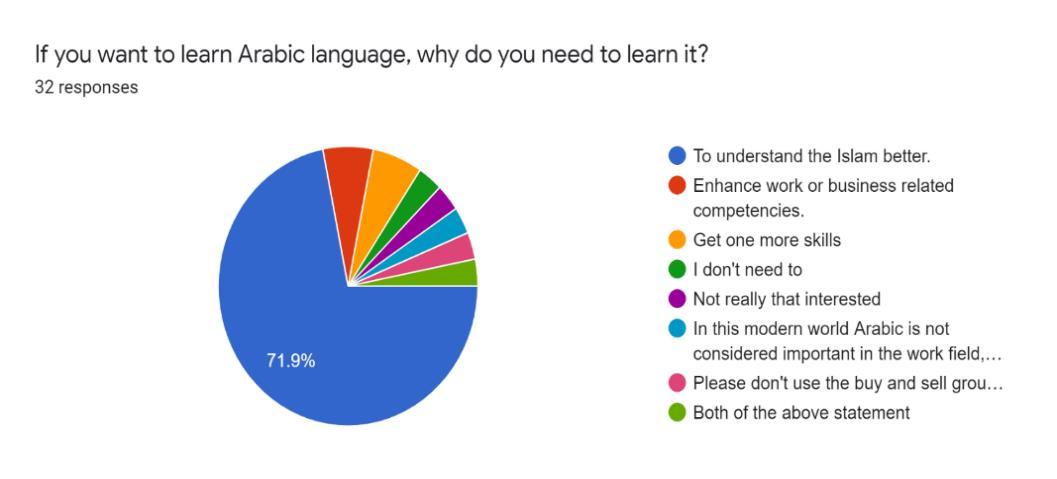
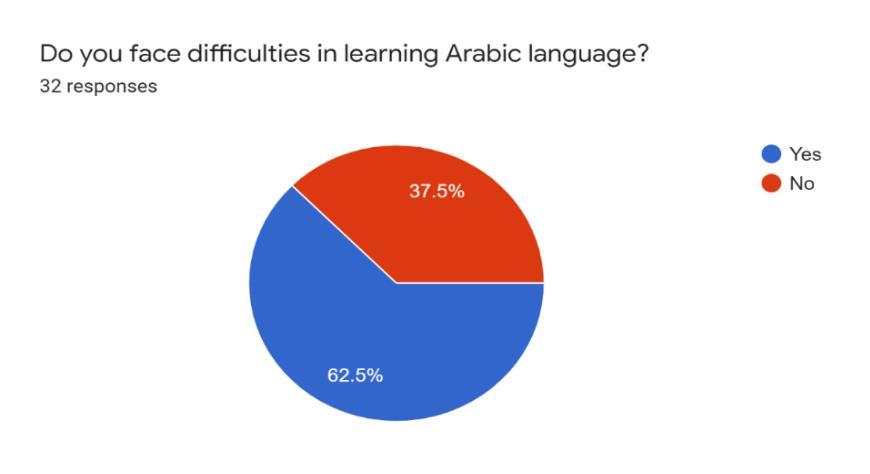
ISSN 2348-1196 (print)
International Journal of Computer Science and Information Technology Research ISSN 2348-120X (online) Vol. 8, Issue 3, pp: (147-160), Month: July - September 2020, Available at: www.researchpublish.com
65.6% of those who want to be teachers or they are already teachers in order to help people to understand the Islam.

75% of responses are familiar with online learning platforms. Furthermore, those who chose „No‟, they are not familiar.
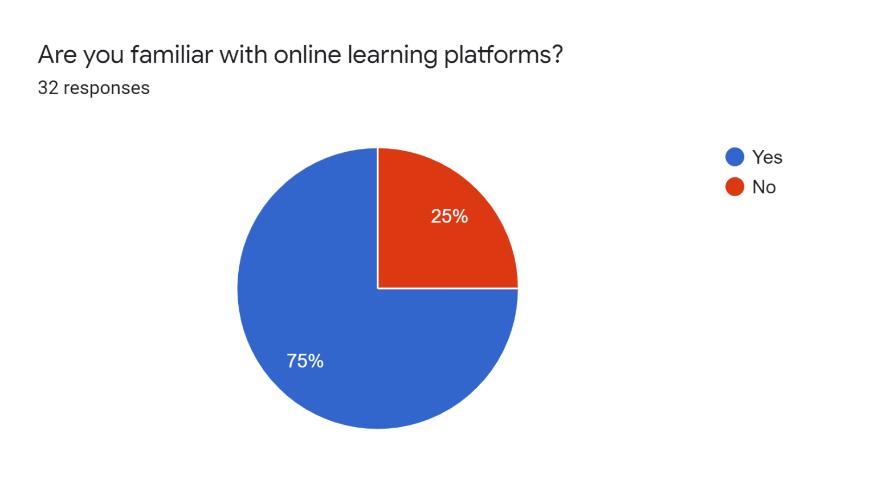
65.6% of responses chose „yes‟ which is a good option to learn Arabic but 34.4% chose „no‟ which learning Arabic language is not a good option for them.
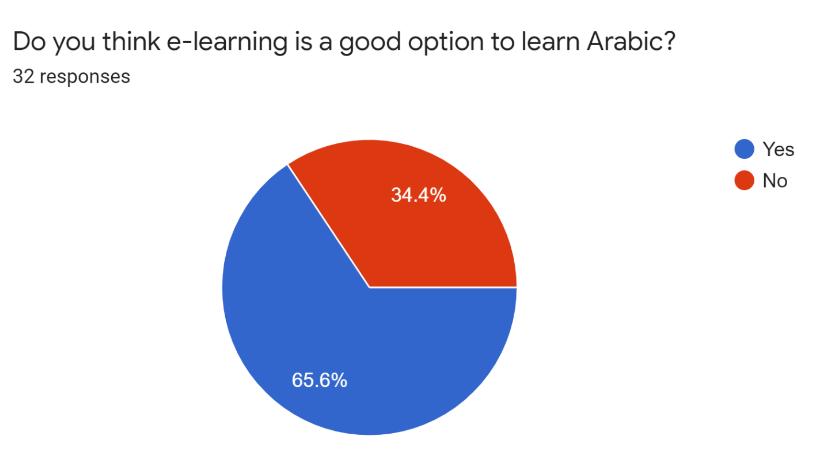
ISSN 2348-1196 (print)
International Journal of Computer Science and Information Technology Research ISSN 2348-120X (online) Vol. 8, Issue 3, pp: (147-160), Month: July - September 2020, Available at: www.researchpublish.com
For those who chose yes, the reasons of choosing that are (Less hassle and requires much lesser time as u can pause videos and go back and forth to learn more, easy to learn it anywhere especially during these difficult days due to COVID-1,[1] he learners can understand what they read in Qur'an). Furthermore, for those who chose „no‟, the reasons are (Face to face session is much more practical, Arabic letters have a unique pronunciation, and online learning wouldn't help the student to learn to correct pronunciation of the letters and hard to guess the word was said by someone.[1]
The key finding after the interviews and the survey is that learning Arabic plays an essential role in Malaysia especially among youth, students, business people as well as tourists. And due to that people are looking enhance their Arabic language to help them self in understanding Islam better since majority of Malaysian are Muslim as well as it will give them more chances to get a job within Malaysia and outside. And due to we are offering Arabic4U platform to help them achieving their goals.
Validated BMC:
1.1 Value Proposition The value proposition defines the value of the programme, services and products that are offered by the Malaysian UotF in satisfying the expectation and needs of the customer segments. The values offered include: time flexibility, help poor student to same education as rich students, offer opportunities for jobs, train student to be qualified to teach, help donors spending their money in a good way, work with the government to establish (UoF), help business people to success in their business as well as tourists.
1.2 Customer Segment: The customer segments describe the different groups of people, communities and organizations that the Malaysian UotF aims to serve. This programme focuses on customer segments that include: all kind of students (poor, normal and rich), teachers, professional volunteers, donors, sponsors, business people, government, tourist agencies.
1.3 Customer Relationship The customer relationships describe the different types of platforms and offers that the Malaysian UotF aims to stay connected and sustain the relationship with the customer segments so as to be continuously relevant to them. The relationship for this programme can be through online engagement & forums, face-to-face, free consultations
1.4 Channels This channel describes the platforms and programme to be used and leveraged by the Malaysian UotF in delivering the Value Propositions to its customer segments. These channels include digital platforms (Arab4U), Network of Mosques [13]
1.5 Key Activities This section describes the important programmes activities to be performed in order to deliver the value propositions offered by the Malaysian UotF to its customer segments. The key activities and programmes include content building, Zakat center services, education management, communication with business people and tourists through events.
1.6 Key Resources Key resources are the important assets required to deliver the value propositions offered by the Malaysian UotF to its customer segments. The key resources include digital platforms e.g. e-learning, teachers and students, sponsors‟ money.
1.7 Key Partners This section describes the external partners with the strategic competencies and values - people or/and organizations, who can collaborate as partners to execute and deliver the value propositions offered by the Malaysian UotF to its customer segments. The key partners include local and international universities collaboration in generating the courses content, training and other academic activities. Government to support in funding and job creation. NGOs, Donors and sponsors to support in fundraising campaigns.
1.8 Cost Structure the Cost Structure defines all costs incurred in order to execute and deliver the value propositions offered by the Malaysian UotF to its customer segments. This includes the costs in executing the key activities by having the key resources in carrying out entrepreneurship programme, salary for teachers and staffs, marketing and advertisements, teaching/researches and community engagement, e-learning platform maintenance and enhancements, training and workshops.
ISSN 2348-1196 (print)
International Journal of Computer Science and Information Technology Research ISSN 2348-120X (online) Vol. 8, Issue 3, pp: (147-160), Month: July - September 2020, Available at: www.researchpublish.com
1.9 Revenue Streams The revenue comes from the customer segments. This is to cover the cost of operations and to implement the programme. The revenue streams include the freemium fees, Zakat/ Waqaf, donations, sponsorship, government, NGOs & private grants.
- Local and International Universities Collaboration.
- Government. - Ngos. - Donors and Sponsors
-Content Building. - Zakat Center Services.
- Education Management. - Communication With Business People And Tourists
- Digital Platforms - eLearning - Teachers and Students. - Money from Sponsors and Donors.
- Time Flexibility.
- Help Poor Student to Same Education as Rich Students.
- Offer Opportunities for Jobs.
- Train Student to Be Qualified to Teach.
- Help Donors Spending Their Money in A Good Way.
- Work with The Government to Establish (Uof).
- Help Business People To Success in Their Business as Well as Tourists.
-Online Engagement & Forums -Face-To-Face, Free Consultations
- Digital Platforms (Arab4U).
-Network of Mosques
-Students (poor, normal and rich).
- Teachers. -professional volunteers. - Donors. -Sponsors. - Business people. -Government. -Tourists.
- Entrepreneurship Programme.
- Salary for Teachers and Staff.
- Marketing and Advertisements.
- Teaching and Community Engagement.
- E-Learning Platform Maintenance and Enhancements.
- Training and Workshops.
- Freemium Fees Zakat/ Waqaf. - Donations. -Sponsorship -Government, NGOs & Private Grants.
In conclusion, this conceptual solution could give many benefits to the users, especially students who are connecting tutors and students remotely together through a collaborative chatting engine. This project attempts to meet the great demand of the Arabic language by employing a reliable teaching methodology and building a solid infrastructure. It proposes an online platform to expose Arabic learners to a web application System that aims to help them to overcome linguistic obstacles, have a good chance to practice with native teachers, as well as reach the main source of the language. The system is providing a collaborative chatting engine in order to connect native and qualified teachers with interested students as well as face to face meetings. Qualified teachers are placed with detailed cards such as name, qualification, and availability. Additionally, offer native speakers to teach and give chances for practicing the language. while at the same creating jobs for others. Arab4U online platforms help students in meeting what they want to learn as well as teachers who do not have work opportunities and have experience in teaching, as well as some schools that spend a lot of money to teach their students. In addition, this paper is a solution for those people who want to learn but they cannot pay for their tuition fees so the system will also build a donation center for B40 people, where donors will be able to directly donate for the B40 people. Arab4 4U develops a solution using the conceptual design approach through a validated business model that enlarge the number of Arabic learning in Malaysia. In addition, by offering online study so it reaches
ISSN 2348-1196 (print)
International Journal of Computer Science and Information Technology Research ISSN 2348-120X (online) Vol. 8, Issue 3, pp: (147-160), Month: July - September 2020, Available at: www.researchpublish.com
many people and build a conceptual UotF biz model, that will enhance the soft skills of an individual as well as it will help the youth with hard skills to survive in the real world.
In the future, Arab4U conceptual business model is going to develop a complete project management plan (PMP) by applying V2MOM (Vision, Values, Methods, Obstacles, and Measures) Model [PMBOK] Arab4U also can provide both application and web-based platforms for their users.
[1] COVID-19 and online teaching in higher education: A case study of Peking University: https://onlinelibrary. wiley.com/doi/full/10.1002/hbe2.191
[2] Dennis, A., Wixom, B., Roth, R., Wixom, B., & Roth, R. (2014). Systems analysis and design (6 ed.).
[3] Latimer, R. (2017, 2 01). Twenty-five Reasons to Study Foreign Languages. Retrieved from Auburn university: https://cla.auburn.edu/forlang/resources/twenty-five-reasons/
[4] Pew, R. C. (2012). Pew Research Center. Retrieved from Pewforum: http://www.pewforum.org/2012/12/18/globalreligious-landscape-muslim/
[5] 4th World Conference on Psychology, Counselling and Guidance WCPCG-2013 Difficulties of learning Arabic for non-native speakers:http://www.globalcenter.info/wcpcg/?page_id=254
[6] Challenges in Learning to Speak Arabic:https://files.eric.ed.gov/fulltext/EJ1112863.pdf
[7] Lewrick, M., Link, P., and Leifer., L (2018). The Design Thinking Playbook: Mindful digital transformation of teams, products, services, businesses, and ecosystems. Wiley.
[8] Osterwalder, A., Pigneur, Y., Clark, T. and Smith, A. (2010). Business model generation: A Handbook for Visionaries, Game Changers, and Challengers. Wiley.
[9] Osterwalder, A., Pigneur, Y., Bernarda, G. and Smith, A. (2014). Value proposition design: How to create products and services customers want. Wiley.
[10] Dahlan, A. R. A., Ibrahim, J., Jalaldeen, M. R. M., & El Mohajir, M. (2020). Redesign “University of the Future” Conceptual Business Model: Sustainability and Staying Relevant in The Digital Age. Journal of Information Systems and Digital Technologies, 2(1), 47–59.
[11] Ibrahim, I., and Dahlan, A. R. A. (2016), Designing Business Models Options for University-of-the-Future. Proceedings of 2016 4th IEEE International Colloquium on Information Science and Technology (CiSt), Tangier, 24-26 October 2016, pp. 600- 603.
[12] Barriers Effecting Successful Implementation of E-Learning in Saudi Arabian Universities Noorulhasan Naveed Quadri, AbulHafeez Muhammed, Sumaya Sanober, Mohamed Rafik N. Qureshi, Asadullah Shah
[13] Dahlan, A.R.A., Osman, R. A. H., Jamaludin, I., & Othman, M.Z. (2016). eHalal4All Program - Promoting Halal Rural Products and Services Globally by Harnessing the Network-of-Mosques (NoM) Capabilities. In Manan, S.K.A., Rahman, F.A., & Sahri, M. (Eds.), Contemporary Issues and Development in the Global Halal Industry. Springer Science+Business Media Singapore.
[14] Teaching Arabic Language to Malaysian University Students using Education Technologies based on Education 4.0 Principles
[15] 4th World Conference on Psychology, Counselling and Guidance WCPCG-2013 Difficulties of learning Arabic for non-native speakers.